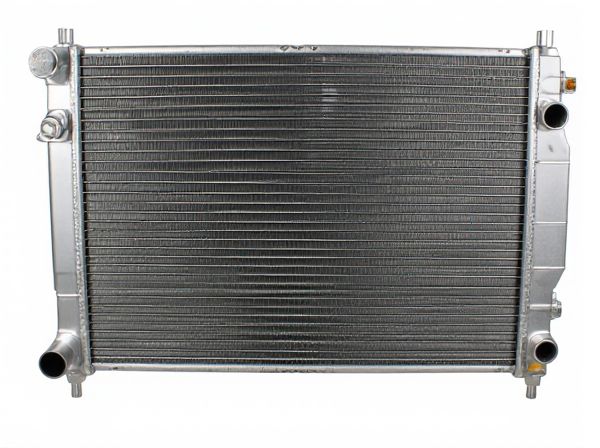
Photo illustration: Two-Row vs Three-Row Radiator
Two-row radiators provide efficient cooling with a more compact design ideal for vehicles with limited engine bay space. Three-row radiators offer increased cooling capacity, making them suitable for high-performance or heavy-duty applications that generate more heat. Your choice depends on balancing cooling needs with available space and vehicle performance requirements.
Table of Comparison
| Feature | Two-Row Radiator | Three-Row Radiator |
|---|---|---|
| Cooling Capacity | Moderate cooling suitable for standard engines | Enhanced cooling for high-performance and heavy-duty engines |
| Size & Weight | Compact and lightweight, fits smaller engine bays | Larger and heavier, may require more installation space |
| Airflow | Optimized for moderate airflow | Increased airflow improves heat dissipation |
| Cost | Generally more affordable | Higher cost due to increased material and complexity |
| Fuel Efficiency Impact | Minimal impact, lighter load on engine | Potential slight reduction due to added weight |
| Application | Daily drivers and light-duty vehicles | Performance cars, towing, and heavy-duty vehicles |
Understanding Radiator Rows: The Basics
Radiator rows refer to the number of horizontal tubes through which coolant flows, with two-row and three-row radiators differing in their cooling capacity and design. Two-row radiators typically offer sufficient cooling for standard engine setups, balancing heat dissipation and airflow, while three-row radiators provide enhanced cooling performance suited for high-performance or heavy-duty applications due to the increased surface area. Understanding the distinction between two-row and three-row radiators helps in selecting the appropriate cooling system based on engine heat generation and operating conditions.
How Radiator Row Count Affects Cooling Performance
A two-row radiator features fewer tubes and fins compared to a three-row, resulting in less surface area for heat dissipation and generally lower cooling capacity. Three-row radiators increase airflow resistance but significantly enhance heat exchange efficiency by providing a larger cooling surface, improving engine temperature regulation under heavy loads. The row count directly impacts coolant flow rate and thermal transfer, making three-row radiators preferable for high-performance or high-temperature environments.
Two-Row Radiators: Key Features and Benefits
Two-row radiators offer enhanced cooling efficiency due to their compact design with dual parallel rows of cooling tubes, allowing better heat dissipation compared to single-row models. Their reduced thickness improves airflow and lowers the overall weight, making them ideal for vehicles with limited space or those seeking improved performance without major modifications. This design also facilitates easier installation and maintenance while maintaining sufficient cooling capacity for typical engine requirements.
Three-Row Radiators: Advantages and Drawbacks
Three-row radiators provide enhanced cooling capacity by offering increased surface area and airflow, which effectively reduces engine temperature and improves performance in high-demand conditions. They offer better heat dissipation compared to two-row radiators, making them ideal for heavy-duty, off-road, or high-performance vehicles. However, the larger size and weight of three-row radiators can impact vehicle fitment and may require modifications, leading to increased cost and potential installation complexity.
Material Differences: Aluminum vs Copper-Brass Radiators
Two-row radiators typically utilize aluminum, which offers superior heat dissipation due to its high thermal conductivity and lightweight properties, optimizing engine cooling while improving fuel efficiency. In contrast, three-row radiators often incorporate copper-brass construction, valued for its durability and excellent heat retention, making it ideal for heavy-duty and prolonged use in high-performance or older vehicle models. The material differences significantly impact cooling efficiency, corrosion resistance, and overall radiator lifespan in automotive applications.
Cooling Efficiency: Two-Row vs Three-Row Radiators
Two-row radiators offer sufficient cooling efficiency for standard engine setups by providing a balanced airflow and heat dissipation surface. Three-row radiators enhance cooling capacity by increasing the surface area and coolant volume, making them ideal for high-performance or heavy-duty vehicles subject to intense thermal loads. The choice between two-row and three-row radiators depends on the engine cooling requirements, operating conditions, and space availability within the vehicle's engine bay.
Compatibility: Which Radiator Fits Your Vehicle?
Two-row and three-row radiators differ primarily in cooling capacity and physical dimensions, impacting their compatibility with specific vehicles. Three-row radiators offer enhanced cooling efficiency, making them ideal for trucks or high-performance cars that generate more heat but require verification of engine bay clearance before installation. Compatibility depends on factors like radiator core size, mounting points, and hose connections, necessitating careful measurement and consultation of vehicle specifications to ensure a proper fit.
Installation Considerations for Two-Row and Three-Row Radiators
Two-row radiators offer easier installation due to their compact size and lighter weight, making them suitable for tighter engine bays or vehicles with limited space. Three-row radiators, while providing enhanced cooling capacity, require more clearance and may necessitate modifications to fit properly, impacting installation time and complexity. Proper assessment of available space, mounting points, and compatibility with existing cooling system components is essential to ensure a secure and efficient installation for both radiator types.
Cost Comparison: Two-Row vs Three-Row Radiators
Two-row radiators generally cost less than three-row radiators due to simpler design and fewer materials required, making them a budget-friendly option for standard cooling needs. Three-row radiators, while more expensive, offer enhanced heat dissipation and improved engine cooling performance, which can justify the higher initial investment for high-performance or heavy-duty vehicles. The cost difference between two-row and three-row radiators typically ranges from 20% to 50%, depending on brand, material, and vehicle compatibility.
Choosing the Right Radiator for Your Driving Needs
A two-row radiator typically offers sufficient cooling capacity for everyday driving and standard engine performance, making it ideal for city commuting and light-duty vehicles. Three-row radiators provide enhanced cooling by increasing surface area, suited for heavy-duty applications, towing, or high-performance driving where engine temperatures tend to rise significantly. Choosing the right radiator depends on your vehicle's engine load, driving environment, and cooling demands to ensure optimal engine efficiency and longevity.
 caratoz.com
caratoz.com